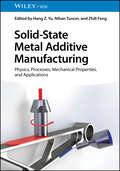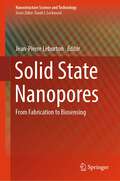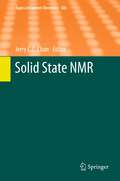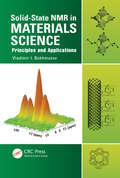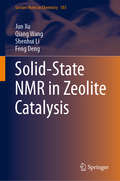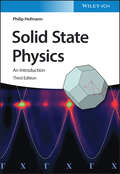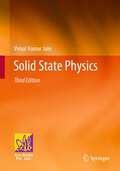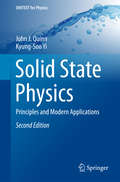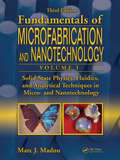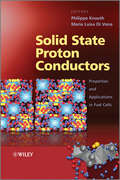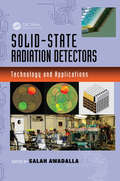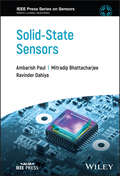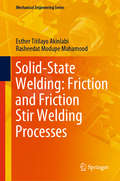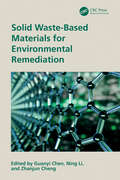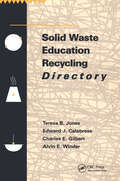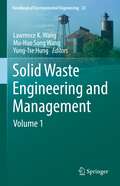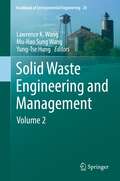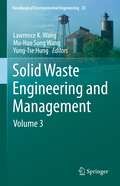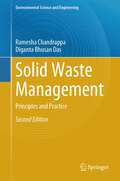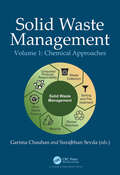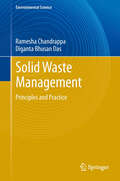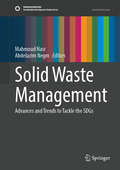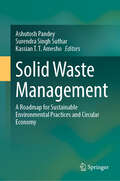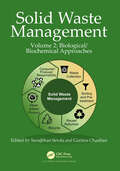- Table View
- List View
Solid-State Metal Additive Manufacturing: Physics, Processes, Mechanical Properties, and Applications
by Hang Z. Yu Nihan Tuncer Zhili FengSolid-State Metal Additive Manufacturing Timely summary of state-of-the-art solid-state metal 3D printing technologies, focusing on fundamental processing science and industrial applications Solid-State Metal Additive Manufacturing: Physics, Processes, Mechanical Properties, and Applications provides detailed and in-depth discussion on different solid-state metal additive manufacturing processes and applications, presenting associated methods, mechanisms and models, and unique benefits, as well as a detailed comparison to traditional fusion-based metal additive manufacturing. The text begins with a high-level overview of solid-state metal additive manufacturing with an emphasis on its position within the metal additive manufacturing spectrum and its potential for meeting specific demands in the aerospace, automotive, and defense industries. Next, each of the four categories of solid-state additive technologies—cold spray additive manufacturing, additive friction stir deposition, ultrasonic additive manufacturing, and sintering-based processes—is discussed in depth, reviewing advances in processing science, metallurgical science, and innovative applications. Finally, the future directions of these solid-state processes, especially the material innovation and artificial intelligence aspects, are discussed. Sample topics covered in Solid-State Metal Additive Manufacturing include: Physical processes and bonding mechanisms in impact-induced bonding and microstructures and microstructural evolution in cold sprayed materialsProcess fundamentals, dynamic microstructure evolution, and potential industrial applications of additive friction stir depositionMicrostructural and mechanical characterization and industrial applications of ultrasonic additive manufacturingPrinciples of solid-state sintering, binder jetting-based metal printing, and sintering-based metal additive manufacturing methods for magnetic materialsCritical issues inherent to melting and solidification, such as porosity, high residual stress, cast microstructure, anisotropic mechanical properties, and hot cracking Solid-State Metal Additive Manufacturing is an essential reference on the subject for academic researchers in materials science, mechanical, and biomedicine, as well as professional engineers in various manufacturing industries, especially those involved in building new additive technologies.
Solid State Nanopores: From Fabrication to Biosensing (Nanostructure Science and Technology)
by Jean-Pierre LeburtonThis contributed volume provides an overview of the recent advances in solid-state nanopore technology, featuring contributions by leading experts in the field. It discusses several aspects of solid-state nanopores, covering their fabrication as well as multiple biosensing applications. It successfully bridges the gap between various scientific and engineering disciplines and highlights the progress made in this area. This title is a useful tool for acquiring basic knowledge of this field and following recent progress. It is a valuable contribution to the area of nanopore biosensing and is of interest to graduate students, postdocs, or senior researchers working in the fields of physical chemistry, biochemistry, bio- and electrical engineering, and biophysics.
Solid State NMR
by Jerry C. ChanDipolar Recoupling, by Niels Chr. Nielsen, Lasse A. Strassø and Anders B. Nielsen.- Solid-State NMR Techniques for the Structural Determination of Amyloid Fibrils, by Jerry C. C. Chan.- Solid-State 19F-NMR of Peptides in Native Membranes, by Katja Koch, Sergii Afonin, Marco Ieronimo, Marina Berditsch and Anne S. Ulrich.- Probing Quadrupolar Nuclei by Solid-State NMR Spectroscopy: Recent Advances, by Christian Fernandez and Marek Pruski.- Solid State NMR of Porous Materials Zeolites and Related Materials, by Hubert Koller and Mark Weiß.- Solid-State NMR of Inorganic Semiconductors, by James P. Yesinowski.-
Solid-State NMR in Materials Science: Principles and Applications
by Vladimir I. BakhmutovSolid-state NMR is a powerful physical method widely applied in modern fundamental and applied science, medicine, and industry. Its role is particularly valuable in materials chemistry due to the capability of solid-state NMR to rapidly solve tasks connected with structural descriptions of complex systems on macro and/or molecular levels, and the i
Solid-State NMR in Zeolite Catalysis (Lecture Notes in Chemistry #103)
by Jun Xu Qiang Wang Shenhui Li Feng DengSolid-State NMR Characterization of Heterogeneous Catalysts and Catalytic Reactions provides a comprehensive account of state-of-the-art solid-state NMR techniques and the application of these techniques in heterogeneous catalysts and related catalytic reactions. It includes an introduction to the basic theory of solid-state NMR and various frequently used techniques. Special emphasis is placed on characterizing the framework and pore structure, active site, guest-host interaction, and synthesis mechanisms of heterogeneous catalysts using multinuclear one- and two-dimensional solid-sate NMR spectroscopy. Additionally, various in-situ solid-state NMR techniques and their applications in investigation of the mechanism of industrially important catalytic reactions are also discussed. Both the fundamentals and the latest research results are covered, making the book suitable as a reference guide for both experienced researchers in and newcomers to this field.Feng Deng is a Professor at Wuhan Institute of Physics and Mathematics, Chinese Academy of Sciences.
Solid State Physics: An Introduction
by Philip HofmannEnables readers to easily understand the basics of solid state physics Solid State Physics is a successful short textbook that gives a clear and concise introduction to its subject. The presentation is suitable for students who are exposed to this topic for the first time. Each chapter starts with basic principles and gently progresses to more advanced concepts, using easy-to-follow explanations and keeping mathematical formalism to a minimum. This new edition is thoroughly revised, with easier-to-understand descriptions of metallic and covalent bonding, a straightforward proof of Bloch's theorem, a simpler approach to the nearly free electron model, and enhanced pedagogical features, such as more than 100 discussion questions, 70 problems--including problems to train the students’ skills to find computational solutions--and multiple-choice questions at the end of each chapter, with solutions in the book for self-training. Solid State Physics introduces the readers to: Crystal structures and underlying bonding mechanisms The mechanical and vibrational properties of solids Electronic properties in both a classical and a quantum mechanical picture, with a treatment of the electronic phenomena in metals, semiconductors and insulators More advanced subjects, such as magnetism, superconductivity and phenomena emerging for nano-scaled solidsFor bachelor’s students in physics, materials sciences, engineering sciences, and chemistry, Solid State Physics serves as an introductory textbook, with many helpful supplementary learning resources included throughout the text and available online, to aid in reader comprehension.
Solid State Physics
by Vimal Kumar JainThe book has been designed as a textbook for graduate and postgraduate students of physics, material science, and engineering. This is the third edition of the textbook, that is updated to reflect recent works in the field. In this edition, some new topics have been introduced while some of the existing topics like phonons, Drude –Lorentz model, Fermi levels, electrons, and holes, etc. are modified. Moreover, the book has complete information on semiconductor devices like tunnel diode, Gunn diode, photodiode, photoconductive diode, varactor diode, solar cell, LED, semiconductor lasers, and semiconductor detectors. All the chapters have been supplemented by solved and unsolved examples. Some of the chapters illustrate areas of current interest in solid-state physics to give the student practical working knowledge of the subject text in a simple and lucid manner. There is a fair amount of detail in the examples and derivations given in the text. Each section of the book has exercises to reinforce the concepts, and problems have been added at the end of each chapter. The detailed coverage and pedagogical tools make this an ideal textbook for students and researchers enrolled in graduate and postgraduate courses of physics, material science, and engineering.
Solid State Physics: Principles And Modern Applications
by John J. Quinn Kyung-Soo YiThis book provides the basis for a two-semester graduate course on solid-state physics. The first half presents all the knowledge necessary for a one-semester survey of solid-state physics, but in greater depth than most introductory solid state physics courses. The second half includes most of the important research over the past half-century, covering both the fundamental principles and most recent advances. This new edition includes the latest developments in the treatment of strongly interacting two-dimensional electrons and discusses the generalization from small to larger systems.The book provides explanations in a class-tested tutorial style, and each chapter includes problems reviewing key concepts and calculations. The updated exercises and solutions enable students to become familiar with contemporary research activities, such as the electronic properties of massless fermions in graphene and topological insulators.
Solid-State Physics, Fluidics, and Analytical Techniques in Micro- and Nanotechnology
by Marc J. MadouProviding a clear theoretical understanding of MEMS and NEMS, Solid-State Physics, Fluidics, and Analytical Techniques in Micro- and Nanotechnology focuses on nanotechnology and the science behind it, including solid-state physics. It provides a clear understanding of the electronic, mechanical, and optical properties of solids relied on in integra
Solid State Proton Conductors
by Philippe Knauth Maria Luisa Di VonaProton conduction can be found in many different solid materials, from organic polymers at room temperature to inorganic oxides at high temperature. Solid state proton conductors are of central interest for many technological innovations, including hydrogen and humidity sensors, membranes for water electrolyzers and, most importantly, for high-efficiency electrochemical energy conversion in fuel cells.Focusing on fundamentals and physico-chemical properties of solid state proton conductors, topics covered include:Morphology and Structure of Solid Acids Diffusion in Solid Proton Conductors by Nuclear Magnetic Resonance Spectroscopy Structure and Diffusivity by Quasielastic Neutron Scattering Broadband Dielectric Spectroscopy Mechanical and Dynamic Mechanical Analysis of Proton-Conducting Polymers Ab initio Modeling of Transport and Structure Perfluorinated Sulfonic Acids Proton-Conducting Aromatic Polymers Inorganic Solid Proton Conductors Uniquely combining both organic (polymeric) and inorganic proton conductors, Solid State Proton Conductors: Properties and Applications in Fuel Cells provides a complete treatment of research on proton-conducting materials.
Solid-State Radiation Detectors: Technology and Applications (Devices, Circuits, and Systems #41)
by SALAH AWADALLA AND KRZYSZTOF INIEWSKIIntegrating aspects of engineering, application physics, and medical science, Solid-State Radiation Detectors: Technology and Applications offers a comprehensive review of new and emerging solid-state materials-based technologies for radiation detection. Each chapter is structured to address the current advantages and challenges of each material and technology presented, as well as to discuss novel research and applications. Featuring contributions from leading experts in industry and academia, this authoritative text:Covers modern semiconductors used for radiation monitoringExamines CdZnTe and CdTe technology for imaging applications including three-dimensional capability detectorsHighlights interconnect technology for current pixel detectorsDescribes hybrid pixel detectors and their characterizationsTackles the integrated analog signal processing read-out front ends for particle detectorsConsiders new organic materials with direct bandgap for direct energy detectionSummarizes recent developments involving lanthanum halide and cerium bromide scintillatorsAnalyzes the potential of recent progress in the field of crystallogenesis, quantum dots, and photonics crystals toward a new concept of x- and gamma-ray detectors based on metamaterialsExplores position-sensitivity photomultipliers and silicon photomultipliers for scintillation crystalsSolid-State Radiation Detectors: Technology and Applications provides a valuable reference for engineers and scientists looking to enhance the performance of radiation detector technology for medical imaging and other applications.
Solid-State Sensors (IEEE Press Series on Sensors)
by Ambarish Paul Mitradip Bhattacharjee Ravinder DahiyaSolid-State Sensors A thorough and up-to-date introduction to solid-state sensors, materials, fabrication processes, and applications Solid-State Sensors provides a comprehensive introduction to the field, covering fundamental principles, underlying theories, sensor materials, fabrication technologies, current and possible future applications, and more. Presented in a clear and accessible format, this reader-friendly textbook describes the fundamentals and classification of all major types of solid-state sensors, including piezoresistive, capacitive, thermometric, optical bio-chemical, magnetic, and acoustic-based sensors. Throughout the text, the authors offer insight into how different solid-state methods complement each other as well as their respective advantages and disadvantages in relation to specific devices and a variety of state-of-the-art applications. Detailed yet concise chapters include numerous visual illustrations and comparative tables of different subtypes of sensors for a given application. With in-depth discussion of recent developments, current research, and key challenges in the field of solid-state sensors, this volume: Describes solid-state sensing parameters and their importance in sensor characterization Explores possible future applications and breakthroughs in associated fields of research Covers the fundamental principles and relevant equations of sensing phenomena Discusses promising smart materials that have the potential for sensing applications Includes an overview of the history, classification, and terminology of sensors With well-balanced coverage of the fundamentals of sensor design, current and emerging applications, and the most recent research developments in the field, Solid-State Sensors is an excellent textbook for advanced students and professionals in disciplines such as Electrical and Electronics Engineering, Physics, Chemistry, and Biomedical Engineering.
Solid-State Welding: Friction and Friction Stir Welding Processes (Mechanical Engineering Series)
by Rasheedat Modupe Mahamood Esther Titilayo AkinlabiThis book presents critical information on the principles and operation of friction welding, friction stir welding, and friction stir processing enhanced with many robust illustrations. It explains the application of these technologies and the current research efforts in the field. The authors explain in detail the advantages offered by these welding processes, in particular their ability to join dissimilar materials not possible to weld in the past. Written for graduate students, researchers, and industrial professionals, the book reinforces concepts presented with case studies on the experimental analysis of welding the dissimilar materials of copper and aluminum, and on friction stir processing.
Solid Waste-Based Materials for Environmental Remediation
by Guanyi ChenThis book provides a multifaceted examination of solid waste management methods, the preparation, properties, and application of solid waste materials in the remediation of various environmental media, as well as the combination of solid waste materials and artificial intelligence.Based on the latest research results and cutting-edge technologies from around the world, the contributors combine the design principles of solid waste materials with application examples, including a complete system, clear routes, and illustrations. They integrate the idea of ecological civilization, the concept of sustainable development, and engineering innovation thinking, providing a reliable reference for resource recycling and contributing to global low-carbon emission.The book is suitable for teachers and students, as well as researchers, industrial technicians, and managers involved in solid waste resources and environmental remediation.
Solid Waste Education Recycling Directory
by Teresa Jones Edward J. CalabreseThis directory thoroughly describes all of the solid waste education programs and materials available from all 50 states. If you are interested in starting a solid waste recycling program or improving what you have-this directory is for you. All programs K-12 are included, in addition to information provided on the other environmental programs available. The solid waste directory gives you names, addresses, phone numbers, materials currently being used, how you can get them, how much they cost or if they are free. This book will be of great interest to city managers and planners. All cities, towns and counties will want this book!
Solid Waste Engineering: A Global Perspective (Activate Learning With These New Titles From Engineering! Series)
by William Worrell P. Vesilind Christian LudwigEquip your students to address the growing and increasingly intricate problem of controlling and processing the refuse created by global urban societies with SOLID WASTE ENGINEERING: A GLOBAL PERSPECTIVE, 3E. While the authors prepare readers to deal with issues, such as regulations and legislation, the book primarily emphasizes developing and implementing solid waste engineering principles. The book first explains basic principles of the field, then demonstrates how to apply these principles in real world settings through worked examples. This proven approach helps your graduate or advanced undergraduate students learn to think reflectively and logically about problems and solutions in today's solid waste engineering.
Solid Waste Engineering and Management: Volume 1 (Handbook of Environmental Engineering #23)
by Lawrence K. Wang Yung-Tse Hung Mu-Hao Sung WangThis book is the first volume in a three-volume set on Solid Waste Engineering and Management. It provides an introduction to the topic, and focuses on legislation, transportation, transfer station, characterization, mechanical volume reduction, measurement, combustion, incineration, composting, landfilling, and systems planning as it pertains to solid waste management. The three volumes comprehensively discuss various contemporary issues associated with solid waste pollution management, impacts on the environment and vulnerable human populations, and solutions to these problems.
Solid Waste Engineering and Management: Volume 2 (Handbook of Environmental Engineering #24)
by Lawrence K. Wang Yung-Tse Hung Mu-Hao Sung WangThis book is the second volume in a three-volume set on Solid Waste Engineering and Management. It focuses on sustainability, single waste stream processing, material recovery, plastic waste, marine litter, sludge disposal, restaurant waste recycling, sanitary landfills, landfill leachate collection, and landfill aftercare as it pertains to solid waste management. The volumes comprehensively discuss various contemporary issues associated with solid waste pollution management, impacts on the environment and vulnerable human populations, and solutions to these problems.
Solid Waste Engineering and Management: Volume 3 (Handbook of Environmental Engineering #25)
by Lawrence K. Wang Mu-Hao Sung Wang Yung-Tse HungThis book is the third volume in a three-volume set on Solid Waste Engineering and Management. It focuses on tourism industry waste, rubber tire recycling, electrical and electronic wastes, health-care waste, landfill leachate, bioreactor landfill, energy recovery, innovative composting, biodrying, and health and safety considerations pertaining to solid waste management.. The volumes comprehensively discuss various contemporary issues associated with solid waste pollution management, impacts on theenvironmental and vulnerable human populations, and solutions to these problems.
Solid Waste Management: Principles and Practice (Environmental Science and Engineering)
by Ramesha Chandrappa Diganta Bhusan DasThis book discusses solid waste management issues from global to local level. It offers an overview of the methods and paradigms of this burgeoning field, ranging from generation, characteristics, quantity, and practical challenges. The book discusses the major issues with respect to environmental health and economy, which are related to solid waste management. Furthermore, it contains updated information on topics such as toxicology, climate change, population pressure, urbanization, energy production, building and community design, and disaster preparedness in the context of solid waste management.
Solid Waste Management: Chemical Approaches, Volume 1
by Garima Chauhan Surajbhan Sevda‘Waste’ is generally identified as goods or material that are perceived to be mostly valueless. However, objects that are perceived to be waste based on consumers’ object valuation can be redefined to create value. This requires a multitude of efforts using different strategies in waste prevention and management. This book is an edited collection of various chemical approaches used for valorization of solid wastes, particularly, waste electrical and electronic equipment, plastic waste, and agro-residue waste, that provide research insights into the concept "waste-to-energy". Covering a variety of interdisciplinary topics on waste treatment and resource recovery makes the book one for all that serves as an excellent reading material for engineers, science scholars, entrepreneurs, and organizations who are working in the field of waste management.
Solid Waste Management
by Diganta Bhusan Das Ramesha ChandrappaSolid waste was already a problem long before water and air pollution issues attracted public attention. Historically the problem associated with solid waste can be dated back to prehistoric days. Due to the invention of new products, technologies and services the quantity and quality of the waste have changed over the years. Waste characteristics not only depend on income, culture and geography but also on a society's economy and, situations like disasters that affect that economy. There was tremendous industrial activity in Europe during the industrial revolution. The twentieth century is recognized as the American Century and the twenty-first century is recognized as the Asian Century in which everyone wants to earn 'as much as possible'. After Asia the currently developing Africa could next take the center stage. With transitions in their economies many countries have also witnessed an explosion of waste quantities. Solid waste problems and approaches to tackling them vary from country to country. For example, while efforts are made to collect and dispose hospital waste through separate mechanisms in India it is burnt together with municipal solid waste in Sweden. While trans-boundary movement of waste has been addressed in numerous international agreements, it still reaches developing countries in many forms. While thousands of people depend on waste for their livelihood throughout the world, many others face problems due to poor waste management. In this context solid waste has not remained an issue to be tackled by the local urban bodies alone. It has become a subject of importance for engineers as well as doctors, psychologist, economists, and climate scientists and any others. There are huge changes in waste management in different parts of the world at different times in history. To address these issues, an effort has been made by the authors to combine their experience and bring together a new text book on the theory and practice of the subject covering the important relevant literature at the same time.
Solid Waste Management: Advances and Trends to Tackle the SDGs (Sustainable Development Goals Series)
by Abdelazim Negm Mahmoud NasrThis book covers the latest advances in sustainable waste management and focuses on its implementation to mitigate water and air pollution, recycle and reuse raw material, and refine valuable metals. In this book, readers will learn about organic waste treatment, emerging waste management techniques, and the transformation of waste into value-added products. Particular attention is given to environmental sustainability and how we can better achieve it through innovative and responsible waste management practices. Divided into 10 chapters, the book outlines a wide range of topics such as the sustainable management of food wastes through cavitation-assisted conversion, rapid bioconversion of animal meat waste into compost using black soldier fly larvae, thermoluminescence properties of combustion-synthesized nanomaterials and their applications for achieving Sustainable Development Goals, and the creative reuse of plastic waste with a case study by Ghanaian artists. Expert contributors uncover new methods and approaches to waste management that invite readers to think critically about the current practices and their impact on the environment. In addition to these discussions, the work explores the challenges of environmental health in waste management for peri-urban areas. This book provides a unique blend of theoretical perspectives and practical case studies that will enrich the understanding of sustainable waste management, and it equips readers with the knowledge needed to contribute to a more sustainable future. The book is an invaluable resource for researchers in the field of environmental science, students at all levels studying sustainability and waste management, and practitioners working in industry.
Solid Waste Management: A Roadmap for Sustainable Environmental Practices and Circular Economy
by Ashutosh Pandey Surendra Singh Suthar Kassian T. T. AmeshoSolid waste management has become a significant global concern, particularly in maintaining and preserving value in solid waste resources. Local socio-economic disparities create various demands for sustainable solid waste management, leading to a wide range of waste reduction, recovery, and recycling solutions. This highlights the importance of accurately interpreting new policies within the framework of the circular economy. Accordingly, the title of this book is Solid Waste Management: Sustainable Environmental Practices and the Circular Economy. This book contains chapters on contemporary research that focuses on innovative technologies, concepts, models, and tools for sustainable solid waste management, as sustainable environmental practices and the circular economy have garnered increasing interest. This volume seeks to enhance scientific potential in the field of sustainable waste management by publishing cutting-edge theoretical and experimental studies that will advance our understanding of green technologies for sustainable solid waste management systems, aligned with the principles of sustainable environmental practices and the circular economy.
Solid Waste Management: Volume 2: Biological/Biochemical Approaches
by Surajbhan Sevda Garima ChauhanWaste materials in the solid form tend to be bulky and difficult to handle and transport. Its management could happen through physical, thermal, chemical or biological processing stages, with the exact sequence of and their operational optima being decided by the waste composition. In recent years, energy crisis and increased waste production have been undoubtedly major issues of concern. As we mentioned in the previous volume of this book, defining waste is crucial in terms of identifying the most adequate approach to recycle or recover resources from the waste. Various chemical, biochemical, and biological approaches are being investigated widely by researchers for waste valorization. Volume 2 of this book brings together the leading researchers working on solid waste management using biological and biochemical approaches.
